A Short History of Picture Postcards in the United States
Pioneer Era (1893-1898)
Although there were earlier scattered issues, most pioneer cards found in collections today began with the cards placed on sale at the Columbian Exposition in Chicago on May 1, 1893. The official cards were issued in a set of twelve views by Charles W. Goldsmith, printed on pre-stamped government postal card stock. Soon after, other publishers began to issue postcards of large cities and popular vacation resorts. Most of these cards were privately printed and, thus, subjected to the full-letter postage rate of two cents, whereas government-issued postal cards could be mailed for one cent. The back side of these early cards was reserved for the address only, so the front side of the card had space to write a short message. Thus, the brief but descriptive "wish you were here" and "having a wonderful time" came into existence.

The empthy space in the upper-right section of the front is intended for the message; the back, which clearly indicates that this is a government-issued postal card, notes "This side is for address only."
Private Mailing Card Era (1898-1901)
On May 19, 1898, private printers were granted permission, by an act of Congress, to print and sell cards that bore the inscription "Private Mailing Card." Today we call these cards PMCs. Postage required was a one-cent adhesive stamp. With this change, a dozen or so American publishers began to take postcards seriously. Writing was still not permitted on the address side; however, many publishers often left a wider border on the side or bottom of the view side so a short message could be added. These cards had to conform to the dimensions of government postal cards: 3.25" x 5.50".

The message written on the front further dates the card to 1900.
Postcard Era: Undivided Back Period (1901-1907)
The use of the word "POSTCARD" was granted by the government to private printers on December 4, 1901. In addition, privately printed postcards could have dimensions of 3.50" x 5.50" like most of the cards published in Europe at the time. Writing was still not permitted on the address side. Also, during this period, Eastman-Kodak introduced its affordable folding camera which made it possible for amateur photographers to take black-and-white photographs and have them printed on paper with postcard backs. These cards are referred to as "Real Photos."

This card was printed in Germany for the Long Island News Company.
Postcard Era: Divided Back Period (1907-1915)
Finally, on March 1, 1907, postal regulations permitted postcards with divided backs, that is, with a printed vertical line down the middle to provide space for both the address and correspondence. The right-hand side of the card was reserved exclusively for the address while the left-hand side could be used for writing a message.
Many millions of cards were published during this period. Up to this point most postcards were printed in Germany, which was far ahead of the United States in lithographic processes. World War I shut down trade with Germany. Thus, postcards had to be produced domestically.

The back of the postcard is divided, now providing room for a message to be written on the left.
White Border Era (1915-1930)
Most American-view cards were printed in the United States during this period, since most European printers were forced out of the American market by high import duties and the ravages of war. High labor costs, along with inexperience in the art of fine printing, led to the production of poor quality cards. To save ink, a border was left around the view. Thus, cards printed during this time are referred to as "White Border Cards." High competition in a narrowing market caused many publishers to go out of business.

Linen Era (1930-1945)

A new technical process was developed that allowed printing on postcards with a high rag content giving them the feel and look of a "linen like" texture. Gaudy dyes were used for bright and vivid coloring making the pictures seem somewhat non-lifelike. Many postcards retained the white or colored border but slowly cards began being printed to the edge of the card. The firm of Curt Teich flourished with its line of linen postcards.
Photochrome Era (1945-present)

with some of the high peaks labelled,
as viewed from Lake Placid, NY
In 1939, a new type of photographic production process called "Photochrome" first appeared on postcards that were being sold by Union Oil Company filling stations in the western United States. These cards, known as "chromes," were easily produced, were of high photographic quality and, more importantly, the images were in true living color. Due to wartime shortages of materials, widespread production of "chromes" did not take off until after World War II. After the war Mike Roberts led the way with "WESCO" cards soon to be followed by other firms such as Dexter Press of Nyack, New York, and Plastichrome Company of Boston. Descriptive information about the view is generally found on the back of cards instead of the front as heretofore seen.